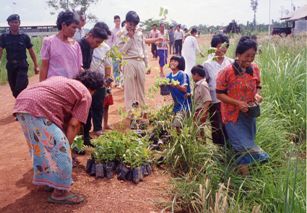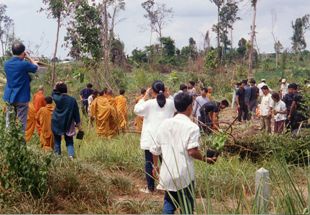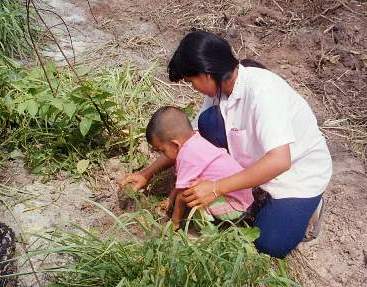


Multipurpose trees in agroforestry
What is agroforestry?
Agroforestry involves raising trees in combination with other agricultural enterprises, including livestock. Different species of trees can be planted with many types of crops in a variety of patterns. For example, fast-growing trees can be planted when the land is fallow or they can be grown at the same time as agricultural crops (figure to come - when I get a scanner!).
In addition to providing fodder, fuel, wood, and other products, trees in agroforestry systems promote soil and water conservation, enhance soil fertility, and act as windbreaks for nearby crops.
What are the best multipurpose trees for agroforestry?
It is important to select the most suitable trees since it is not easy to replace them once they have been planted. The following factors should be kept in mind when selecting tree species.
Environmental adaptation
A multipurpose tree must be able to adapt to the area's climate, soil, topography, and plant and animal life. This is especially important for exotic species, that is, species introduced from outside the project area or from outside the country.
Needs of farmers
The species should meet the needs of farm families. For this reason, it is important to involve farmers, both men and women, in selecting species. They should identify desired tree products and planting locations based on local markets aswell as conservation needs.
The cost of acquiring seedlings or cuttings should also be kept in mind. Planting stock of most fruit trees, for example, are expensive.
Ease of maintenance
Some species are more difficult to look after than others. Farmers should consider beforehand how much time they have to care for the trees. If they require additional skills and knowledge to grow a particular species, training or demonstration programs should be organised.
Availability of genetic materials
Seeds or seedlings of the species being considered must be easy to obtain. If vegetative propagation is required, farmers should receive training in how to do this. Seeds of Gliricidia sepium and Sesbania spp., for example, might not be readily available. Farmers may need help in how to propagate the trees using root cuttings. They may not even have enough time to harvest the cuttings.
Role of trees in agroforestry
Alley cropping
When planted as hedgerows between rows of agricultural crops, some tree species reduce soil erosion. When planted on slopes, alley crops slow down runoff rainwater and trap sediment, which can form natural terraces after several years.
Alley cropping means growing hedgerows of closely spaced trees (20cm or less) between rows of food crops. If the land slopes, farmers should plant the hedgerows along the contour, that is, the trees in each hedgerow should be planted at the same level of slope (Figure to come).
Farmers should prune hedgerows regularly to prevent them from competing with nearby crops for sunlight and water. When pruned regularly, hedgerows can provide a reliable source of animal fodder and fuel. Farmers can cut the trees when they become competitive and carry the branches to pens where animals are sheltered. Longer cutting cycles of 4-6 months provide relatively more wood than shorter cycles. Short cycles produce relatively more foliage. Most species should not be pruned more often than every 30 days (see species fact sheets).
If planted in double lines rather than single lines, hedgerows can produce almost twice as much foliage and wood, without greatly increasing the competition with nearby crops for water, nutrients, and sunlight. Where farmers can plant in a north-south rather than east-west direction, this will reduce competition for sunlight. Whether farmers plant single or double rows depends on how much land is available and the slope.
"Green manure" refers to foliage and twigs that are spread among food crops as mulch and organic fertiliser to improve their growth. To obtain green manure, farmers canprune the tops of the hedgerows every 6-8 weeks.
Desirable characteristics of species
- Easily established: require minimum labour for planting and maintenance.
- Fast growing: benefits become available to the farm family as soon as possible.
- Good sprouting: hedgerows continue to grow regularly after pruning.
- Nitrogen fixing: leguminous (nitrogen-fixing) species can contribute to crop nutrition.
- Heavy and palatable foliage: provide more green manure and acceptable fodder.
- Deep root system: nutrients and water are drawn from lower soil layers.
- Easy to propagate: generally, growing hedgerows from seed requires less labour than vegetative propagation.
- Adaptable to close spacing: hedgrows require dense planting.
Home gardens and other multistorey systems
Homegardens, mixed plantings of annual and tree crops around dwellings, are a common type of multostory agroforestry system. Multistory means that there are at least two layers of plants growing to different heights in the system. In homegardens, the lowest level often consists of vegetables or root crops; the second level includes fast-growing trees or crops such as bananas, spices, and cacao; a third higher level may consist of large trees that provide fruit, timber and shade. Homegardens also provide a pleasant shaded living area (Figure 18).
Many farmers already grow multipurpose trees in their homegardens for flowers, fruits, and seeds. If farmers want to grow a tree for its food rather than its wood or leaves, they should plant seedlings at least 5m from each other.
Also, trees grown mainly for food should not be pruned regularly for fodder or fuel. Pruning can interfere with flowering and fruiting. Instead, farm families can collect fallen branches for fuelwood.
Women make many of the decisions on how to tend the homegarden. They often choose the species to be grown. Attempts to improve the use of trees in homegardens should involve dicsussions with women and men farmers to better understand how they use trees and what products should be optimised.
Other multistory systems include those where trees in famrlands are left to grow amid the food crops (Figure 19). In coffee or cacao plantations, growers pland fast-growing species to provide shade.
Desirable characteristics of species
- Cast the desired amount of shade: understory crops need the right amount of light for optimum growth. Typically, the crown should be high, small, open, and foliage sparse.
- Deep rooted: they can draw nutrients and water from deeper soil layers and will not compete with shallow-rooted crops.
- Roots should not spread laterally too far from the trunk: to minimise competition with nearby crops.
- Nitrogen fixing: to grow well under adverse conditions and help improve soil fertility.
Living fences
In many places, farmers plant multipurpose trees in rows along farm boundaries as "living fences". In addition to providing fodder and fuelwood, living fences provide privacy and protection from browsing animals.
Desirable characteristics of species
- Tolerate minor "injuries": living fences are susceptible to frequent injuries from pruning or animals and should tolerate them well.
- Fast growing: provide benefits to farm families as soon as possible.
- Compatible with annual and perennial crops: should not have adverse effects on other tree species or crops they are associated with.
- Provide fodder: serve as a source of animal feed.
- Fire resistant: act as a fire break.
- Thorns: stiff branches, thorns, spines, nettles, or irritating latex help keep animals out if that is a problem.
- Vegetative propagation: ensures fast establishment while reducing the chance of spreading to pasture and cultivated areas.
Windbreaks
Wundbreaks are strips of trees, shrubs, and vines planted closely together along the edges of croplands perendicular to winds, prevailing. Especially in dry areas, windbreaks can provide protection to crops and soils from the detrimental effects of wind.
Some examples of MPTS as windbreaks and living fences
| Species | Climate | Other uses |
| Acacia nilotica | arid, semiarid tropics | beverage, fuelwood |
| Azadirachta indica | semiarid tropics | timber, lumber, manure, essential oils, fuelwood |
| Casuarina equisetifolia | humid tropics | fuelwood, timber |
| Eucalyptus camaldulensis | humid tropics | fuelwood, timber |
| Gliricidia sepium | humid tropics | food, fuelwood, poles, fodder |
| Grevillea robusta | subhumid tropics, humid tropics | timber, fuelwood, building materials |
| Leucaena leucocephala | humid subtropics, humid tropics | fuelwood, poles timber fodder |
| Sesbania grandiflora | humid tropics | fodder, fuelwood, food |
Windbreaks provide protection to crops over a distance equivalent to 15-20 times the height of the trees in the windbreak. For large areas, windbreaks shouls be planted at this distance from each other. For example, windbreaks comprising trees that grow to a height of 8m should be planted not more than 120-160m apart.
Farmers should replace dead trees from time to time. As the trees in the windbreaks grow larger and compete with each other, farmers should remove some of them.
Desirable characteristics of species.
- Wind resistant: withstand strong winds.
- Deep spreading root system: adds stability to the windbreak by making the trees less susceptible to wind damage.
- Small open crown: reduces the risk of wind damage.
- Easy to propagate: minimises labour inputs.
Improved fallow systems
In many regions, population increase has resulted in faster rotation cycles of crop cultivation and shorter fallow periods. In some instances, fallow time is simply too short to allow the soil to recover. Blocks of fast-growing trees, particularly species that fix nitrogen in the soil, can help the soil recover as well as provide fuel, poles and fodder. Farmers can plant stump cuttings in the fields at the same time as the harvest of the last annual crops before the fallow period. The cuttings do not shade other crops until after 4-6 months.
Desirable characteristics of species
- High nitrogen content in tissue: hastens soils rejuvenation, since nitrogen is the most important deficiency of tropical soils.
- Fast biomass production: litter from the tree, especially foliage, can add important nutrients to the soil.
Trees and raising livestock
Farm systems that combine tree plantations with livestock that graze beneath them are found generally in drier areas, where natural grasslands and farm sizes are larger. In such systems, farmers graze sheep or cattle on forage grasses or in stands of trees.
In wetter areas, which tend to have smaller land holdings, alley cropping and other "cut and carry" methods for procuring fodder are more important.
Some advantages of MPTS as sources of fodder
| Species | Climate | Other uses |
| Acacia tortillis | semiarid tropics | fuelwood |
| Albizia lebbek | humid tropics, semiarid tropics | fuelwood, timber |
| Calliandra calothyrsus | humid tropics | lumber, fuelwood |
| Dalbergia sissoo | semiarid tropics | timber, fuelwood |
| Gliricidia sepium | humid tropics | food, fuelwood, poles |
| Leucaena leucocephala | humid subtropics, humid tropics | fuelwood, poles, crop shade, timber |
| Prosopis cineraria | semiarid tropics, arid tropics | windbreak |
| Sesbania grandiflora | humid tropics | fuelwood, food |
| Ziziphus mauritiana | semiarid tropics, subhumid tropics | food, shade |
Advantages to integrating tree growing with livestock production include:
- increasing the production of meat protein without sacrificing large tracts of agricultural land.
- reducing surface soil erosion by preventing open frazing and reducing dependence on grasses.
- using animal manure to fertilise the soils and intercrops, reducing reliance on inorganic fertiliser.
- providing additional income through sale of livestock.
Desirable characteristics of species
- High protein and nutrient content: improve livestock nutrition.
- Palatable: livestock are selective about what fodder they will eat.
- Free of toxic substances: some fodder species contain toxic substances that can be consumed only in small amounts. Leucaena spp, for example, contain mimosine which, in large dosed, is harmful to animals. It must, therefore, be used in combination with other fodder sources.
- Sprout well: recover rapidly after pruning.
Stabilising stream banks and gullies
Trees can help reduce soil erosion along streams and gullies. They should be planted at the medium to high-level water mark. Their roots serve to hold the soil in place and reduce the impact of storm water.
Suitable species
Some tree species suitable for stabilising stream banks and gullies are Paraserianthes falcataria, Gmelina arborea, Leucaena leucocephala, Sesbania grandiflora, and Moringa oleifera.
Suggested reading
Buck, Louse E. 1990. Agroforestry Extension Training Sourcebook. New York: CARE.
International Institute of Rural Reconstruction. 1992. Agroforestry technology Information Kit. Cavite, Philippines: IIRR.
MacDicken, KG and NT Vergara, eds, 1990. Agroforestry: Classification and Management. New York: John Wiley and Sons.
Mellink, W, YS Rao and KG MacDicken, eds. 1991. Agroforestry in Asia and the Pacific. Bangkok: FAO-RAPA.
Nair, PKR, ed. 1989.Agroforestry Systems in the Humid Tropics. Dordecht, Netherlands: Kluwer Academic Publishers.